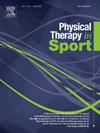短足运动对胫骨内侧应力综合征患者的急性影响:准实验研究
IF 2.2
3区 医学
Q1 REHABILITATION
引用次数: 0
摘要
目的分析患有胫骨内侧应力综合征(MTSS)的跑步者在进行短足运动(SFE)后,比目鱼肌激活峰值和后足外翻峰值是否会立即发生变化。其次,确定无症状者与MTSS患者之间比目鱼肌激活峰值和后足外翻峰值的差异:主要结果测量使用肌电图测量腓肠肌激活情况,通过三维运动学分析测量后足内翻情况。结果SFE降低了MTSS组9公里/小时(p = 0.017)和15公里/小时(p = 0.019)的比目鱼肌激活峰值,降低了NPG组15公里/小时(p <0.001)的比目鱼肌激活峰值,这表明神经肌肉效率有所提高,胫骨应力可能有所降低。SFE 对后足外翻峰值没有明显影响。踝关节外翻运动范围与肌肉激活之间存在明显的相关性(r = 0.585 至 0.849,p < 0.05)。这些研究结果表明,SFE 可以提高神经肌肉的效率,减少胫骨压力,并强调了踝关节灵活性在肌肉激活中的作用。本文章由计算机程序翻译,如有差异,请以英文原文为准。
Acute effects of the short-foot exercise in runners with medial tibial stress syndrome: A quasi-experimental study
Objectives
Analyze whether there are immediate changes in peak soleus activation and peak hindfoot eversion after short-foot exercise (SFE) in runners with medial tibial stress syndrome (MTSS). Secondarily, establish differences in peak soleus activation and peak hindfoot eversion between asymptomatic individuals and those presenting MTSS.
Design
Quasi-experimental study.
Setting
University Laboratory.
Participants
Thirty-two runners participated: 16 with MTSS and 16 in the no-pain group (NPG).
Main outcome measures
Soleus activation was measured using electromyography, and hindfoot eversion via 3D kinematic analysis. Participants performed SFE, and running data were collected at 9,12 and 15 km/h pre- and post-intervention.
Results
SFE reduced peak soleus activation at 9 (p = 0.017) and 15 km/h (p = 0.019) for the MTSS group and at 15 km/h (p < 0.001) for the NPG, suggesting improved neuromuscular efficiency and potentially reduced tibial stress. SFE did not significantly affect peak hindfoot eversion. Significant correlations were found between ankle dorsiflexion range of motion and muscle activation (r = 0.585 to 0.849, p < 0.05). These findings suggest SFE could improve neuromuscular efficiency and reduce tibial stress, and highlights ankle flexibility's role in muscle activation.
Conclusions
SFE significantly reduces soleus activation, potentially improving neuromuscular efficiency and decreasing tibial stress.
求助全文
通过发布文献求助,成功后即可免费获取论文全文。
去求助
来源期刊

Physical Therapy in Sport
医学-康复医学
CiteScore
4.50
自引率
8.30%
发文量
125
审稿时长
39 days
期刊介绍:
Physical Therapy in Sport is an international peer-reviewed journal that provides a forum for the publication of research and clinical practice material relevant to the healthcare professions involved in sports and exercise medicine, and rehabilitation. The journal publishes material that is indispensable for day-to-day practice and continuing professional development. Physical Therapy in Sport covers topics dealing with the diagnosis, treatment, and prevention of injuries, as well as more general areas of sports and exercise medicine and related sports science.
The journal publishes original research, case studies, reviews, masterclasses, papers on clinical approaches, and book reviews, as well as occasional reports from conferences. Papers are double-blind peer-reviewed by our international advisory board and other international experts, and submissions from a broad range of disciplines are actively encouraged.
 求助内容:
求助内容: 应助结果提醒方式:
应助结果提醒方式:


